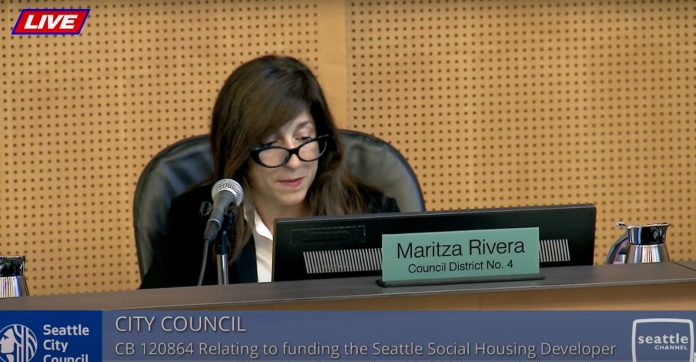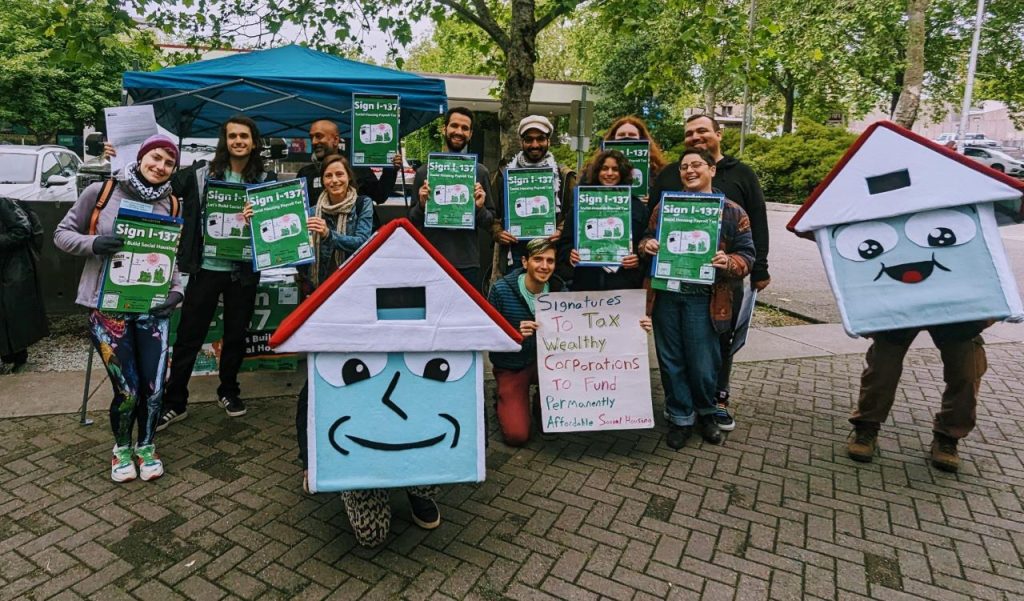
The Seattle City Council voted Thursday to interject itself into the debate over funding social housing, opting to place a competing measure on the February ballot that raids existing affordable housing funds to fund a small pilot program. Only Councilmember Tammy Morales, a vocal supporter of social housing, voted against putting the competing measure on the ballot. Councilmembers Dan Strauss and Cathy Moore were absent.
The grassroots Initiative 137 relies on a high earners tax of 5% on individual compensation above $1 million to create a new dedicated revenue stream estimated at $50 million annually for the Seattle Social Housing Developer to create mixed-income housing. House Our Neighbors gathered more than 38,000 signatures from Seattleites to put the measure on the ballot, building on the successful previous ballot initiative to authorize the public developer in 2023, in which I-135 garnered 57% of the February special election vote.
In contrast, the council measure, spearheaded by Councilmember Maritza Rivera, would divert existing affordable housing dollars earmarked in the JumpStart fund to the tune of $10 million per year for five years. Affordable housing providers turned out against the proposal, saying it would sap resources and hurt their effort to produce deeply affordable housing. Among them was Jon Grant, Chief Strategy Officer for the Low Income Housing Institute, the largest provider of affordable housing in the region.
“This proposal would significantly reduce the funding available to stabilize the city’s nonprofit housing sector at the worst possible time,” Grant said. “Instead, we desperately need the city to prioritize JumpStart dollars to establish an operating fund to stabilize underwater properties. The affordable housing sector is in freefall, and this only deepens the crisis. Please vote no on this alternative.”
House Our Neighbors and other social housing backers testified against the council alternative for sabotaging the goal of creating social housing by lowering funding level, revised affordability model, and bypassing the high-turnout presidential-year ballot in November, which is the ballot I-137 would be on if Council had not delayed action to whip up their alternative. Council’s stipulation that all city funding pay for affordable housing below 80% of area median income (AMI) could effectively rule out their mixed income model, which intends to use rents from tenants earning incomes near the median to cross subsidize rents for lower-income tenants, with all living in the same building.
Nonprofit builders generally produce buildings with 100% affordable units based on funding requirements from various public sources. Council would effectively force the same model on the Seattle Social Housing Developer, when the whole point was to pioneer a new complementary model to create mixed-income communities, with the potential to be self-perpetuating by investing rent revenue in more social housing production.

While several councilmembers painted the Seattle Social Housing Developer as ill-prepared and unprofessional, House Our Neighbors co-executive director Tiffani McCoy emphasized the experienced affordable housing professionals on the board and the new CEO. “The CEO, Roberto Jimenez, comes from California with over three decades of development experience,” McCoy said.
“Mayor Bruce Harrell has voiced his support for voters to have an alternative on the ballot,” Rivera said. “We’re all in agreement we need more affordable housing in Seattle. We are all aligned in that goal. This alternative is also aligned with that goal. It balances the need for innovation with the need for accountability. It allows the Seattle Social Housing developer, a new public development authority, to show what they can build here in Seattle, but it won’t give a blank check to yet another new agency that does not have the experience creating housing.”
Rivera and her allies painted the pilot program structure as fiscally prudent, although it redefined the housing that the voter-approved social housing developer would build, which seemingly prevents a proof of concept for the original plan.
“If social housing PDA shows proof of concept and positive outcomes, this alternative gives the city the ability to expand the PDA’s efforts, as you heard from Central Staff on Tuesday, the alternative compels the new social housing effort to abide by the same parameters that Seattle’s existing affordable housing providers comply with. The goal is to ensure public dollars are spent wisely and effectively while creating much needed housing.”
House Our Neighbors supporters also stressed that their plan had always involved two measures since Washington state law prevents a two-subject ballot measure that would have both established and funded a development authority. The I-137 plan involved a dedicated funding source both for the sake of dependability and not siphoning off existing affordable housing funding.
“We always were clear that this is a two step process: create the developer and then fund it,” House Our Neighbors Policy Director Tiffani McCoy said. “That is what we are doing. We strongly oppose defunding JumpStart and defunding the housing levy. We’re glad the housing levy was taken off the table, but we are very opposed to JumpStart being defunded. They need that money. The affordable housing providers, the Equitable Development Initiative, the Green New Deal — they need that money.”
Both measures will appear side by side on the Seattle ballot in a special election in February 2025. Based on state law, voters will be asked if they want to fund any type of housing initiative, and if that question clears 50%, then the option that receives the most votes will be enacted into law. Seattle’s last example of this type of binary choice vote was approval voting versus ranked choice voting in 2022, when ranked choice voting won out. The format will look something like what’s shown below, with the council’s alternative listed as Proposition 1B, city council communications director Brad Harwood said:
- Should either of these measures be enacted into law?
Yes____
No __
- Regardless of whether you voted yes or no above, if one of these measures is enacted, which one should it be?
Proposition 1 A __
Proposition 1 B __
It’s a rather complicated decision matrix in a low turnout special election when a relatively small subset of Seattle voters will determine the outcome. The February 2023 election had 33% turnout compared to 88% turnout in the 2020 general election.
Or as Councilmember Rob Saka put it: “Given that both initiatives will be presented together, we’re centering choice, optionality, and I trust the judgment of voters to make the ultimate decision. So today, that’s what we’re doing. We’re giving voters an important choice.”
How many voters engage in that decision this winter remains to be seen.
Update: This article was updated at 11:42am Friday to note that the council alternative will appear on the ballot as Proposition 1B. House Our Neighbor’s measure will be Proposition 1A.
Doug Trumm is publisher of The Urbanist. An Urbanist writer since 2015, he dreams of pedestrian streets, bus lanes, and a mass-timber building spree to end our housing crisis. He graduated from the Evans School of Public Policy and Governance at the University of Washington in 2019. He lives in Seattle's Fremont neighborhood and loves to explore the city by foot and by bike.

